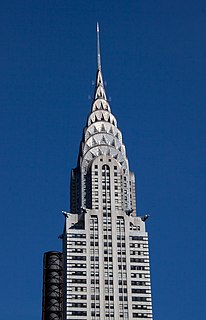
Art Deco, sometimes referred to as Deco, is a style of visual arts, architecture and design that first appeared in France just before World War I. Art Deco influenced the design of buildings, furniture, jewelry, fashion, cars, movie theatres, trains, ocean liners, and everyday objects such as radios and vacuum cleaners. It took its name, short for Arts Décoratifs, from the Exposition internationale des arts décoratifs et industriels modernes held in Paris in 1925. It combined modern styles with fine craftsmanship and rich materials. During its heyday, Art Deco represented luxury, glamour, exuberance, and faith in social and technological progress.
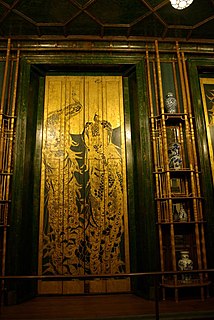
Aestheticism is an intellectual and art movement supporting the emphasis of aesthetic values more than social-political themes for literature, fine art, music and other arts. This meant that art from this particular movement focused more on being beautiful rather than having a deeper meaning — "art for art's sake". It was particularly prominent in Europe during the 19th century, supported by notable figures such as Walter Pater and Oscar Wilde, but contemporary critics are also associated with the movement, such as Harold Bloom, who has recently argued against projecting social and political ideology onto literary works, which he believes has been a growing problem in humanities departments over the 20th century.

The Eastlake Movement was an American nineteenth-century architectural and household design reform movement started by architect and writer Charles Eastlake (1836–1906). The movement is generally considered part of the late Victorian period in terms of broad antique furniture designations. In architecture the Eastlake Style or Eastlake architecture is part of the Queen Anne style of Victorian architecture.
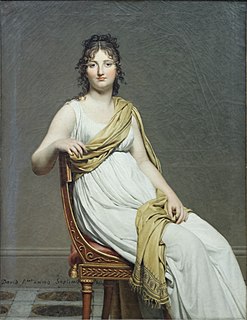
Directoire style describes a period in the decorative arts, fashion, and especially furniture design concurrent with the post-Revolution French Directory. The style uses Neoclassical architectural forms, minimal carving, planar expanses of highly grained veneers, and applied decorative painting. It is a style transitional between Louis XVI and Empire.
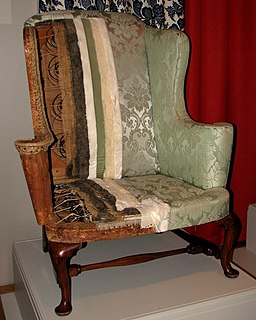
Upholstery is the work of providing furniture, especially seats, with padding, springs, webbing, and fabric or leather covers. The word upholstery comes from the Middle English word upholder, which referred to an artisan who held up their goods. The term is equally applicable to domestic, automobile, airplane and boat furniture, and can be applied to mattresses, particularly the upper layers, though these often differ significantly in design. A person who works with upholstery is called an upholsterer. An apprentice upholsterer is sometimes called an outsider or trimmer. Traditional upholstery uses materials like coil springs (post-1850), animal hair, coir, straw and hay, hessians, linen scrims, wadding, etc., and is done by hand, building each layer up. In contrast, today's upholsterers employ synthetic materials like dacron and vinyl, serpentine springs, and so on.

Hanover is a town in the Canadian province of Ontario with a population of about 7,650 residents. It is located in southwestern Grey County, bordering on Bruce County, west of Durham and east of Walkerton on Grey/Bruce Road 4. Hanover has a city hall, police department and the Hanover and District Hospital.

Louis-Jean-Sylvestre Majorelle, usually known simply as Louis Majorelle, was a French decorator and furniture designer who manufactured his own designs, in the French tradition of the ébéniste. He was one of the outstanding designers of furniture in the Art Nouveau style, and after 1901 formally served as one of the vice-presidents of the École de Nancy.
18th-century French art was dominated by the Baroque, Rocaille and neoclassical movements.

The International Exhibition of Modern Decorative and Industrial Arts was a World's fair held in Paris, France, from April to October 1925. It was designed by the French government to highlight the new style moderne of architecture, interior decoration, furniture, glass, jewelry and other decorative arts in Europe and throughout the world. Many ideas of the international avant-garde in the fields of architecture and applied arts were presented for the first time at the Exposition. The event took place between the esplanade of Les Invalides and the entrances of the Grand Palais and Petit Palais, and on both banks of the Seine. There were 15,000 exhibitors from twenty different countries, and it was visited by sixteen million people during its seven-month run. The Style Moderne presented at the Exposition later became known as "Art Deco", after the name of the Exposition.
Virginia furniture is furniture that originates from the U.S. state of Virginia. Furniture was first produced in Virginia during the Colonial period and continued through the Industrial Revolution. Furniture production has decreased in recent times due to imported furniture, but Virginia is still home to a few large furniture companies.
Ébéniste is the French word for a cabinet-maker.
John Jacques may refer to:

A Hoosier cabinet is a type of cupboard or free–standing kitchen cabinet that also serves as a workstation. It was popular in the first few decades of the 20th century, since most houses did not have built–in kitchen cabinetry. The Hoosier Manufacturing Co. of New Castle, Indiana, was one of the earliest and largest manufacturers of this product, causing the term "Hoosier cabinet" to become a generic term for that type of furniture. By 1920, the Hoosier Manufacturing Company had sold two million cabinets.

Jacques Adnet was a French art deco modernist designer, architect and interior designer.
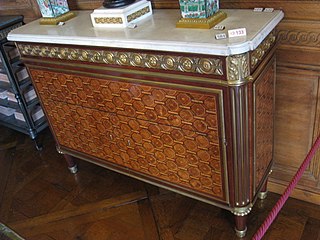
French furniture comprises both the most sophisticated furniture made in Paris for king and court, aristocrats and rich upper bourgeoisie, on the one hand, and French provincial furniture made in the provincial cities and towns many of which, like Lyon and Liège, retained cultural identities distinct from the metropolis. There was also a conservative artisanal rural tradition of French country furniture which remained unbroken until the advent of the railroads in the mid-nineteenth century.

Newman Brothers at The Coffin Works is a museum in the Newman Brothers Coffin Furniture Factory building in the Jewellery Quarter conservation area in Birmingham, England. The museum educates visitors about the social and industrial history of the site, which operated from 1894–1998 as a coffin furniture factory. The museum opened in October 2014 after a fifteen-year campaign by the Birmingham Conservation Trust to save the factory building, which ceased trading in 1998, and raise the funds to transform it into a heritage attraction. Located at 13–15 Fleet Street, the building is Grade II* listed.
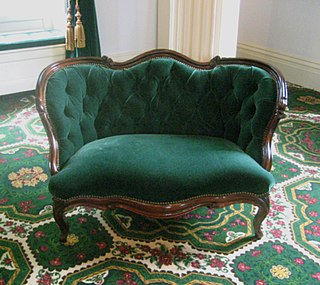
The Rococo Revival style emerged in Second Empire France and then was adapted in England. Revival of the rococo style was seen all throughout Europe during the 19th century within a variety of artistic modes and expression including decorative objects of art, paintings, art prints, furniture, and interior design. In much of Europe and particularly in France, the original rococo was regarded as a national style, and to many, its reemergence recalled national tradition. Rococo revival epitomized grandeur and luxury in European style and was another expression of 19th century romanticism and the growing interest and fascination with natural landscape.

Jacques Hitier was a French interior architect and designer. In his book, Patrick Favardin introduces him as “one of the most prominent figures of decorative art of the second half of the twentieth century”. He was also a director of the Paris L'École Boulle, School for Fine Arts and Crafts and Applied Arts, from 1972 to 1982.















